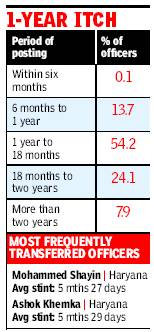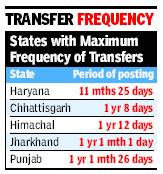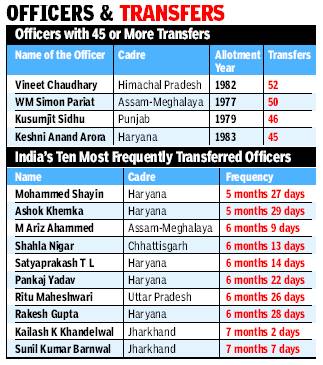Indian Administrative Service (IAS)
This is a collection of articles archived for the excellence of their content. Readers will be able to edit existing articles and post new articles directly |
Contents |
Cadre strength
2017: sanctioned strength vs. incumbent officers
Bharti Jain, IAS vacancies at alarming level of 23%, says panel, March 16, 2017: The Times of India
Vacancies in the higher echelons of the bureaucracy have reached “alarming levels“, with a shortfall of 1,470 IAS officers as on January 1, 2016, a parliamentary panel has said, adding that such persistent shortage of officers in key positions at the Centre and in state governments affected governance.
In a report presented in Parliament, the parliamentary standing committee on personnel, public grievances, law & justice said the shortage of IAS officers had been a perennial problem since 1951, but “now the vacancy position has increased to an alarming level“ with only 4,926 incumbent officers against a sanctioned strength of 6,396 (77%) as per the civil list dated January 1, 2016.
The panel strongly recommended that all efforts be made to fill up the vacancies, either by utilising the additional capacity at the Lal Bahadur Shastri National Academy of Administration (LBSNAA) to train more IAS officers or increasing the training capacity.
According to the report, the panel was informed of 1,470 officer vacancies in the IAS -about 900 vacancies from the direct recruitment quota and the rest from states' promotion quota. The DoPT secretary had told the panel that the direct recruitment shortfall was primarily due to two reasons -cadre review was done very recently , increasing the number of posts, and for 10 years, recruitment has been abnor mally low. He stated that direct recruitment could not be stepped up all of a sudden as the training capacity for IAS officers was only 180 per year.Moreover, if a large number of officers were inducted in one go, there would be problem of cadre management.
The panel, however, noted that the LBSNAA director had informed it that the academy had the capacity to train more than 180 officers. The panel said it failed to understand why lack of training capacity had been cited as a reason for not addressing the vacancies.
2018: sanctioned strength vs. incumbent officers
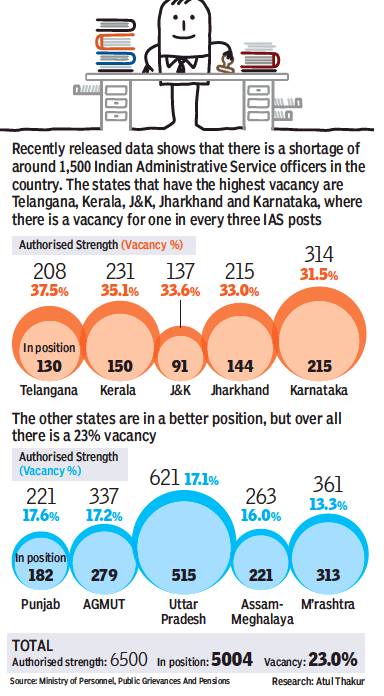
From: March 22, 2018: The Times of India
See graphic:
The Indian Administrative Service: sanctioned strength vs. incumbent officers, 2018
2022: vacancies, state-wise

From: Bharti Jain , March 28, 2022: The Times of India
See graphic:
2022: IAS cadre vacancies, state-wise
SUSPENSION RULES FOR IAS
State can keep IAS officer under suspension, pending disciplinary action
Suspension to continue only if Centre (DoPT) confirms it
State can’t delay report beyond maximum 90 days without Centre’s confirmation
For disciplinary proceedings, IAS officer presents reply to chief secretary
The chief secretary, a state’s top bureaucrat, can take a call to either continue suspension or revoke it based on report
State must then send report to Centre for confirmation
Opinion of Centre prevails
If Centre goes by state’s report, suspended officer can move court — Central Administrative Tribunal (CAT)
CAT acts as arbiter. Takes into account Centre’s and state’s recommendations and officer’s version
CAT judges if state followed due procedure as per service rules in suspending officer
During this period, officer in question receives half pay & housing facility
Period of suspension on charges other than corruption can’t exceed a year, pending further inquiry
If inquiry not completed within a year, suspension order stands revoked
Officer can be suspended for one year maximum, pending inquiry
Frequency of transfers
68% IAS officers have avg stints of 18 mths or less
Most Transferred Civil servant Shifted 52 Times In 31 Years
Atul Thakur TIG
1976-2003 batches: Average tenures of 18 months or less
Ashok Khemka has become famous as a much-transferred IAS officer, but he is far from being the only one to have been shunted ever so often. An analysis of the executive record (ER) sheets of thousands of IAS officers currently in service reveals that frequent transfers are depressingly common.
It shows that 68% (over two-thirds of the officers have had average tenures of 18 months or less. The analysis used ER sheets of all 2,139 officers now in service who were selected through the UPSC’s civil services exam and had completed 10 years or more of service on November 13, 2013, the date on which this analysis was undertaken.
Among these officers, Vineet Chaudhary, a 1982 batch Himachal Pradesh cadre officer, has been transferred 52 times, the highest in the country. Similarly, Assam-Meghalaya cadre officer Winston Mark Simon Pariat has been transferred 50 times in his 36-year career. Kusumjit Sidhu of the Punjab cadre witnessed 46 transfers in a career which spanned over three decades and like his famous colleague Khemka, Haryana cadre officer Keshni Anand Arora is also serving her 45th posting.
There are 13 officers who have undergone 40 or more transfers in their career. Interestingly, seven of these are from the Haryana cadre alone. Himachal and Jharkhand have two such officers each while Assam-Meghalaya and Uttar Pradesh account for one IAS officer each with 40 or more transfers.
The number of transfers alone doesn’t explain the difficulties of the prestigious job. It is the frequency which is more alarming. On this count too, Haryana emerges as the worst state for an IAS officer to be posted in. Five of the country’s 10 most frequently transferred officers are from Haryana; two from Jharkhand and one each from Chhattisgarh, UP and Assam-Meghalaya. ==Shayin, Khemka most transferred civil servants Mohammed Shayin and Khemka — both Haryana cadre — are India’s most frequently transferred IAS officers, their average frequency being more than once in six months. Similarly, the average time spent between two postings for M Ariz Ahammed, Shahla Nigar, Satyaprakash TL, Pankaj Yadav, Ritu Maheshwari and Rakesh Gupta has been less than seven months. Kailash Kumar Khandelwal and Sunil Kumar Barnwal, who also make it to the list of the country’s 10 most frequently transferred officers, have been transferred within seven months and seven days of posting, on an average.
TOI’s analysis suggests that roughly 14% officers get transferred within one year of service and another 54% within 18 months. In other words, 68%, or over two-thirds of India’s top bureaucrats, last on an average less than 18 months at a posting. Only 8% of the officers analyzed had average tenures of more than two years and there are only 14 officers who have managed to complete an average stay of more than three years between transfers.
So how do the frequent transfers impact bureaucracy, the officials and the general public? “Frequent transfers impact the working of the system and demoralize the bureaucracy,” says Bhoosreddy. honorary secretary of the Central IAS association, “The family of the officer is the worst sufferer. It affects children’s education and in many cases increases the financial burden as the transfers often cause job loss of the officer’s spouse”, he adds. He further argues that the poor and the vulnerable section is the worst hit as transfers severely impact welfare schemes. “Above all, the common man has to bear the burden of the additional administrative cost of transfer allowance,” he says.
The 15th report of the Second Administrative Reforms Commission stated that appointments at the highest level of administration often lack transparency and objectivity. The report observed that transfers often coincide with a change in political regime. This leads to instability of administration and lack of faith in the system among the common people.
News reports have also repeatedly confirmed politically motivated transfers and today it is not unusual for ordinary people to associate a particular official with a politician or party. “Transfers with change in political executive are a reality after 1970s and this tendency is raising the question of neutrality of the bureaucracy”, adds Bhoosreddy. Other sources, on condition of anonymity, told TOI that many times during a political vacuum between regimes, honest bureaucrats in senior positions get the chance to issue marching orders to corrupt subordinates.
State-wise analysis
A state-wise analysis of the frequency of IAS transfers once again shows that Haryana is the worst to work in. On an average, an IAS officer is transferred in 11 months and 25 days in the state. Chhattisgarh, Himachal Pradesh, Jharkhand and Punjab are other states that show up badly on this parameter. A bird’seye view of state-wise transfer data suggests that states which are perceived as badly governed tend to be the ones where IAS transfers are more frequent.
2010-2014 property returns: An analysis
The Times of India, Sep 14 2015

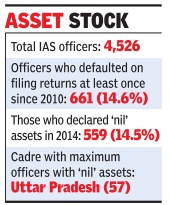
Defaulting babus: Tripura is worst Almost one out every seven IAS officers who file property returns claim to have no property , be it land, building or house. Analysis of immovable property returns by a website, factly.in, that aims to make public data more meaningful to citizens, shows that of about 3,800 IAS officers who have been filing immoveable property returns since 2010, 559 or 14.5% declared that they have no property in their submission to the Centre for the financial year 2014.
The highest number of officials who claimed to own no property were from UP (57),
followed by MP (42). The AGMUT (Arunachal PradeshGoa-Mizoram and Union Territory) cadre had 37 such officers, with Maharashtra (33) and Tamil Nadu (31) fourth and fifth. Former chief information commissioner and erst while bureaucrat Wajahat Habibullah said, “It is possible for 14.5% of the officers not to have any property but I won't think it is credible. It is a somewhat high number for officials or their spouses not to have any property,“ Habibullah said. He added that officers at the beginning of their career may not have property but by midcareer, most of them did. According to the department of personnel and training (DoPT), there are 4,526 IAS officials of which 3,865 filed their returns for all years since 2010.
Factly .in analyzed IPRs filed by IAS officers from 2010-2014 to find that 14.6% -that is 661 of 4,526 -had defaulted at least once in filing their returns.
The worst performing batch where most number of officials (83.7%) defaulted at least once in filing returns was the 2013 batch. The worst performing cadre was Tripura with only 38.2% compliance. Among the best performing batch was 1977 with 100% compliance while the cadre was Maharashtra with 96.3% compliance.
See also
Indian Administrative Service (IAS)
Government servants/ employees: India (statistics)
Government servants: India (legal issues, rules)
